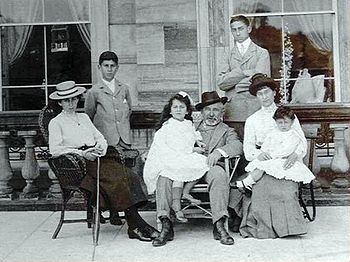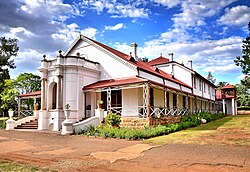Sammy Marks
Sammy Marks | |
|---|---|
Transvaal Union of South Africa | |
| Nationality | Lithuanian |
| Organization | Business |

Samuel Marks (11 July 1844 – 18 February 1920) was a Russian Empire-born South African industrialist and financier.
Life history
Born the son of a Jewish tailor in 1844 in
With the discovery of gold in the boomtown of
Marks contributed generously to Jewish communities all over South Africa.
Sammy Marks tickey


In 1898 Marks was allowed the extraordinary privilege of using the state mint for a day. Marks used the opportunity to strike 215 gold tickeys – three-penny pieces that were normally silver – as mementos for his relatives and friends, including President Kruger and members of the
For many years Marks had planned an iron and steel works in the Transvaal, and had visited Britain to inspect the installations there at first hand. When he landed a contract with the Government in 1911 for smelting large quantities of scrap metal, he founded in 1912 the Union Steel Corporation.
Sammy Marks died in Johannesburg on 18 February 1920.

Family life
At forty years of age and a very wealthy man, Marks started thinking about marriage. He returned to Sheffield in England and married Bertha Guttmann, eighteen years his junior. This was an arranged marriage set up by Bertha's father who helped with Sammy's success during the years. Bertha was only 5 years old when Sammy set foot on the Cape's soil. From this union nine children were born, six boys and three girls. Only six children survived infancy. Having himself received a limited schooling, Marks set great store by education and saw to it that the children were taught at home by governesses – boys until the age of eight, girls until the age of twelve and then they were sent to private schools in England.
Sammy could speak 5 different languages and had a great mind for business.
Marks had bought the farm Zwartkoppies to the east of Pretoria and there he began the construction of his home. The name originates from the black rock around the farm which has iron in and is by nature black rocks. This also attracts electric storms. He drew the initial plans for the house on a piece of wood and got a local builder to construct the house according to his rough sketch plan. The house is a very cold place as he built the house facing West which does not work in the Southern Hemisphere.
Marks built a grand 40 odd room Victorian mansion, Zwartkoppies Hall, on the farm near Pretoria, which became well known to celebrities and dignitaries visiting South Africa. Sammy and Bertha moved into the house in 1886. Sammy had an Italian painter paint the walls on silk material so that the walls would look like they were made of silk. Beautiful patterns decorated each room of the mansion. Having the same restless energy that led to Marks's success, his wife Bertha controlled the house and its staff with ease, managing to raise nine children, breed poultry, maintain a garden, and entertain on a lavish scale. Luncheons, dinners, croquet on the lawn, tennis and billiards parties were all regular events. There was no dinner party, and no Sunday, which passed without a 5 course meal attended by 30+ guests. A staff of 13, most of whom were engaged through an agency in London, carried out the housework: parlourmaids, kitchenmaids, laundrymaids and gardeners, as well as a governess, a cook, an estate carpenter and a Scottish butler. A massive stove in the kitchen, with five ovens and 10 hot-plates, testified to the scale of the entertainment.
Bertha, having married a very wealthy man, was often abroad buying décor for the mansion from France, Germany, India etc.
Dolly was the youngest daughter to be born; doctors was afraid she wouldn't make it after birth as she only weighed 780 grammes at birth. She lived a full life and died aged 96 years. The oldest son, Louis was very full of himself and had this attitude after studying in England, referring to himself as "Young Lord Louis" , even signing his letters with the initials "YLL". Sammy once entered a party where the coat boy took his hat and jacket and tipped the young man a generous 1 pound. After taking the tip, the boy turned to Sammy and asked if he could tip him more as his son Louis tipped him five pounds when he came in earlier. Sammy looked at the young man and replied with a well thought comeback: "Remember that my son has a very rich father, I on the other hand, do not."
Gertrude was Sammy's oldest daughter and also favourite child as they were the closest to one another. She was very talented and went to England for her studies, where she met a young Christian boy. She was only sixteen at the time. After writing her father a very long letter explaining to him that she had met the love of her life and intended to marry him and convert to Christianity, Sammy being a Russian Jew, he was disappointed and livid at the same time. He immediately sent for her to be fetched and brought back to South Africa where Gertrude, heartbroken, refused to marry in her life. She kept herself busy by attending charities and helping the less fortunate, but she never courted a man. She is buried on the Zwartkoppies farm.
Joseph was the son who never wanted to be a businessman, and told his father that he wanted to be a farmer when grown up. He demanded his curtains, bedding, carpet, everything in his room be the colour of green. Joseph studied agriculture and ran the farm after the death of his father, in addition to running his own nearby farm. Not liking the mansion's walls being decorated by the beautiful patterns, he painted over them, causing extensive damage. The mansions walls are being renovated as the funds are available, being painstakingly removed by a scalpel, carefully not to damage the original layer. Six layers of paint by Joseph nearly destroyed 171 years of art.
Museum
 | |
 | |
| Coordinates | 25°45′01″S 28°22′49″E / 25.75015°S 28.38024°E |
|---|---|
| Website | Sammy Marks Museum |
| Ditsong Museums of South Africa network | |
After Marks' death, his widow and some of the children lived in the house until the death of the last one in 1981. After a period of standing vacant, the family realised it was in need of maintenance and a suitable tenant was sought. In 1984 an agreement was reached with the National Cultural History Museum according to which the Government was to buy the contents of the house from the estate, restore the house and rent it from the family trust. In 1986 the Sammy Marks Museum opened its doors to the public. In 1995 roughly 73ha surrounding the house and upon which all of the historical buildings are situated, was cut from the rest of the farm and sold to the National Cultural History Museum. Today the Sammy Mark's Museum forms part of the Ditsong Museums of South Africa. Every Sunday a brass band plays in the gardens of Zwartkoppie Hall.
Gallery
-
Sammy Marks House, Zwartkoppies, Pretoria
See also
- List of Castles and Fortifications in South Africa
References
- Sammy Marks Museum
- SA History
- SA National Archives
- SA Coin
- Sammy Marks
- Sammy Marks: The Uncrowned King of the Transvaal ISBN 0-8214-0998-0
- Standard Encyclopaedia of Southern Africa vol.7 (Nasou, Cape Town 1972) ISBN 0-625-00323-3
- Sammy Marks: A new picture taken from the Lewis family album
- Specific
- ISBN 0-8214-0998-0.
- ^ Church Square, the Old Synagogue and the Old Government Printing Work, Three historic places for testing strategic intervention University of Pretoria. 2015



